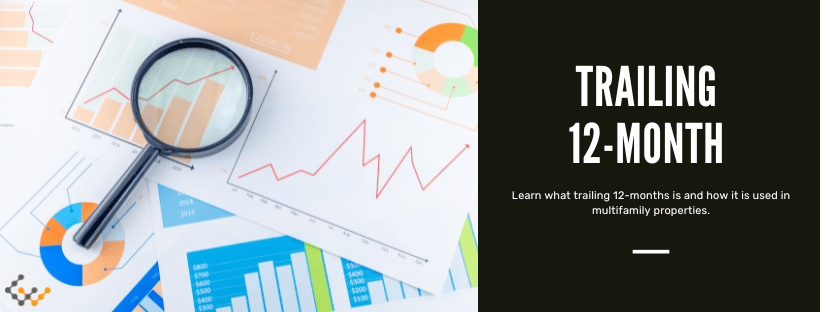What is a Trailing Twelve Months Period?

The financial performance of commercial real estate property is reported over various periods, including both back-looking and forward-looking periods. One of the most common periods used when evaluating multifamily properties is the trailing 12-month period.
What Is A Trailing 12-Month Period?
The trailing 12-month period is the most recent 12 months. The last full month constitutes the final month in the period, and the one 11 months prior constitutes the first in the period. The period thus rolls throughout the year.
How Are Trailing 12-Month Financials Used for Commercial Real Estate?
Lenders, investors and others may examine trailing 12-months real estate financials for several reasons.
The most common is to assess a property’s stability and trend, especially for multifamily properties that usually have year-long leases. The financials can reveal a property’s current cash position, cash flow and profitability, as well as how those have each shifted over the past year.
Trends can be more precisely identified by comparing the T12 with the T3. A trend that’s evident in T12 financials can be confirmed by T3 financials that continue the trend or accelerate it. T3 financials that don’t match the trend might indicate the trend is slowing or stopping. (Of course, whether these trends are good or bad depends on the trend itself.)
Any leased property’s profitability can be fairly thoroughly assessed by examining the T12 and rent roll. Adding the rent roll report is helpful for multifamily properties, but it’s particularly necessary when evaluating other leased properties that have longer terms.
How Should Investors Prepare TTM Financial Statements?
Investors should consult with the lender or other party that’s requesting TTM financials, in order to determine exactly what documents are wanted:
- Income statements must be generated if the period doesn’t coincide with a quarterly, semi-annual or annual reporting period, in which case the statements are likely already drafted.
- Cash flow statements must be generated if the period doesn’t coincide with a quarterly, semi-annual or annual reporting period, in which case the statements are likely already drafted.
- Balance sheets can be printed on demand, as balance sheets should always be kept current.
How is TTM Calculated in Commercial Real Estate?
TTM in real estate can be checked by counting the most recent 12 months on a calendar. To make a quick TTM calculation:
- The most recent full month constitutes the last month of the period
- 11 months before that most recent one constitutes the first month of the period
Trailing 12 Months Examples
For example, assume the date is sometime in January 2023. The TTM would be January 2022 – December 2022, regardless of when in January 2023 it is. The TTM for February 2023 would be February 2022 – January 2023. During November 2023, the TTM would be November 2022 – October 2023.
At times, the trailing 12-month period coincides with other reporting periods. It’ll match up with quarterly reporting periods during April, July, October and January. It’ll match up with annuals during January. The monthly period rolls to the next month without waiting for the longer quarter/annual period, though.
Can TTM Be Used for All Types of CRE?
Trailing twelve months can be used for all types of commercial real estate, as every property has a theoretical 12 months of financial statements. Those statements may differ based on property type, and they might contain “not applicable” or “null” for new and/or dormant properties.
The trailing 12-month period is much more often used for certain types of properties, however. While raw land should have a theoretical TTM, the statements would provide virtually no valuable information. Statements are much more important for multifamily property.
Multifamily properties are where TTM is most often used. These properties frequently have 12-month leases, and the previous 12 months’ financials could reveal a lot about a property.
TTM is less often used for non-residential commercial properties. Offices, retail stores, manufacturing facilities, entertainment venues, and other non-residential properties tend to have much longer leases. Only reviewing the past 12 months’ leases would yield minimal insights.
Nonetheless, there are situations where TTM is needed for these other property types. The financial statements can be fairly illuminating when examined alongside other reports.
Wrapping Things Up: Trailing Twelve Months
The trailing twelve months is a standard request that all commercial real estate investors should be prepared for. It’ll almost certainly be requested when working on multifamily properties, and very well could be requested when working on other properties. There’s no more efficient way to assess a property’s financials for the past year.
So long as your property’s financials are current and in order, preparing TTM financial statements shouldn’t be an issue. This is just one step to attend to as you proceed with financing or evaluation.


